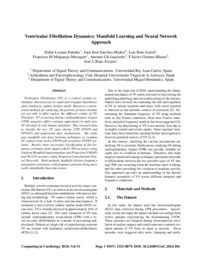Por favor, use este identificador para citar o enlazar este ítem:
https://hdl.handle.net/11000/37196
Ventricular Fibrillation Dynamics: Manifold Learning and Neural Network Approach
Título :
Ventricular Fibrillation Dynamics: Manifold Learning and Neural Network Approach |
Autor :
Lozano-Paredes, Dafne 
SANCHEZ MUÑOZ, JUAN JOSE 
Bote-Curiel, Luis 
Melgarejo Meseguer, Francisco Manuel 
Gil Izquierdo, Antonio 
Gimeno Blanes, Francisco Javier
Rojo-Álvarez, José Luis  |
Editor :
CinC Community |
Departamento:
Departamentos de la UMH::Ingeniería de Comunicaciones |
Fecha de publicación:
2024 |
URI :
https://hdl.handle.net/11000/37196 |
Resumen :
Ventricular Fibrillation (VF) is a critical cardiac arrhythmia characterized by rapid and irregular heartbeats, often leading to sudden cardiac death. Moreover, conventional methods for analyzing the patterns of heart rhythms are not able to fully explore the different origins of VF. Therefore, VF occurring during cardiopulmonary bypass (CPB) surgeries offers a unique opportunity to study how VF develops in real human situations. This research aims to classify the two VF types during CPB (VFON and VFOFF) and understand their mechanisms. The study uses manifold and deep learning techniques to examine VF signals from twelve VFON and seventeen VFOFF patients. Results show successful classification of the frequency evolution of the signal with 81.36% accuracy using Uniform Manifold Approximation and Projection (UMAP) and 90.52% accuracy using Temporal Convolutional Neural Networks. Both methods highlight distinct frequency and pattern variations, with frequency patterns being more easily identifiable than time events.
|
Área de conocimiento :
CDU: Ciencias aplicadas: Ingeniería. Tecnología |
Tipo de documento :
info:eu-repo/semantics/article |
Derechos de acceso:
info:eu-repo/semantics/openAccess
Attribution-NonCommercial-NoDerivatives 4.0 Internacional |
DOI :
https://doi.org/10.22489/CinC.2024.106 |
Publicado en:
Computing in Cardiology |
Nombre Congreso:
CINC 2024 |
Aparece en las colecciones:
Artículos Ingeniería Comunicaciones
|
 La licencia se describe como: Atribución-NonComercial-NoDerivada 4.0 Internacional.
La licencia se describe como: Atribución-NonComercial-NoDerivada 4.0 Internacional.

 La licencia se describe como: Atribución-NonComercial-NoDerivada 4.0 Internacional.
La licencia se describe como: Atribución-NonComercial-NoDerivada 4.0 Internacional.
.png)